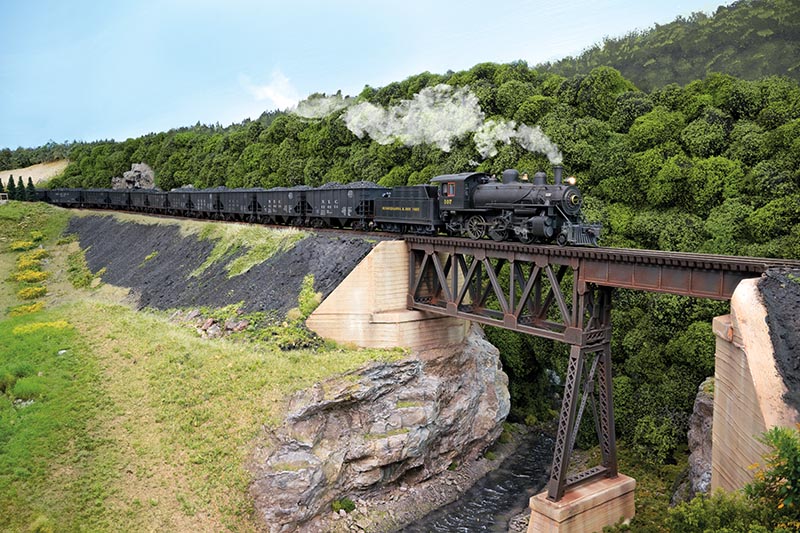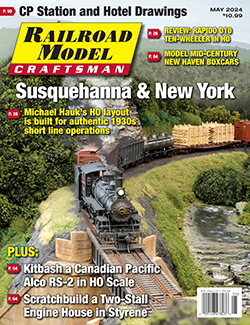 by Michael Hauk/photos by the author
by Michael Hauk/photos by the author
My HO scale model railroad is based on the Susquehanna & New York Railroad, a short line common carrier once located in the mountains of central Pennsylvania north of Williamsport. S&NY ran from Newberry, Pa. (just west of Williamsport on the West Branch of the Susquehanna River), north along Lycoming Creek via trackage rights over the Pennsylvania Railroad Elmira Branch to Marsh Hill, Pa. From Marsh Hill, the S&NY sent its own right-of-way northeast in the narrow Pleasant Stream Valley, climbing upgrade to Ellenton, and then downgrade along Schrader Creek to the S&NY’s eastern terminus at Towanda, Pa., on the North Branch of the Susquehanna. The railroad served the lumber town of Masten; the small farming villages of Wheelerville, Ellenton, and Monroeton; sawmills and wood-chemical factory at Laquin, and a large tannery at Powell. In addition, a short branch to Ralston served a tannery and small coal mines. At Newberry, the S&NY interchanged mostly with New York Central, Erie, and Reading railroads, and the PRR to a lesser degree. The main interchange with the PRR was at Marsh Hill. At Towanda, the S&NY interchanged with Lehigh Valley.
The S&NY was a wholly owned subsidiary of the U.S. Leather Company, and was originally built to harvest hemlock bark for tanning operations. Traffic on the prototype S&NY was therefore largely based on timber and wood products. Large hemlock and hardwood mills run by the Central Pennsylvania Lumber Co. (another U.S. Leather subsidiary) were located at Masten and Laquin. Laquin also was the site of a large wood-chemical plant, a small veneer factory, a kindling-wood factory, and a hub and stave mill. Tanneries operated by other U.S. Leather subsidiaries were located at Ralston and Powell, and a glue factory was built to utilize the by-products of tanning operations at Newberry. The eastern end of the S&NY was constructed over the remains of the old Barclay Railroad, which dated back to 1856, and was constructed to haul coal mined on Barclay Mountain to canal boats on the Susquehanna River at Towanda.
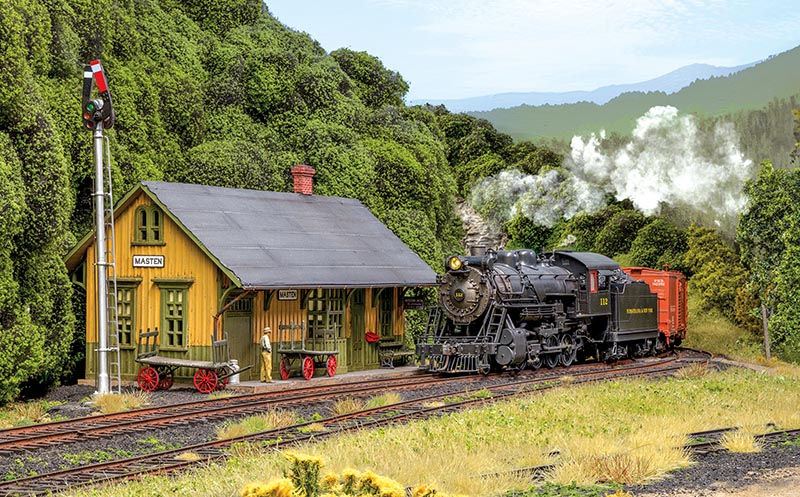
ABOVE: Train 25, the westbound local, arrives at the logging town of Masten, Pa. The train order board is green, indicating “No Orders” to 25’s crew. A single onlooker awaits 25’s arrival on this day.
Traffic on the S&NY peaked in the mid-1920s. As the largest tracts of timber were cut and depleted, the lumber mills went into decline, and were largely gone by the early 1930s. The wood-chemical plant was shuttered in the early 1930s, as the hardwood supplies were exhausted, and the chemical processes used to extract charcoal, methanol, and acetic acid from wood were superseded by other methods.
However, as the threatening clouds of war loomed in Europe in the late 1930s, overhead interchange traffic from New York Central and Reading at Newberry, and the Lehigh Valley at Towanda, became an important source of revenue and the S&NY was back in the black (barely).
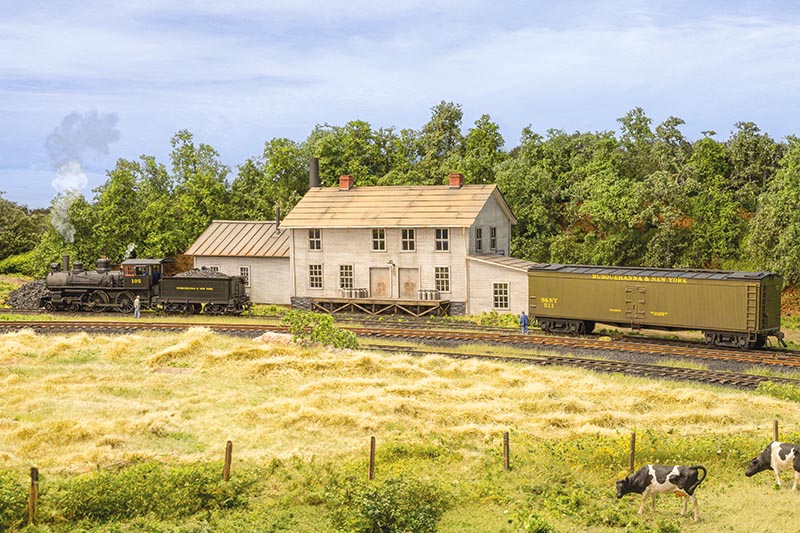
ABOVE: Westbound S&NY afternoon passenger local Train 3 headed by engine 104 spots a milk can car at the Dairymen’s League creamery at Wheelerville on a September afternoon in 1940. The locomotive is a Bachmann Spectrum engine lightly weathered by the author and equipped with a TCS WOWSound decoder.
Unfortunately, the demand for material during World War II sent scrap metal prices through the roof, and despite making a small profit every year, the scrap value of the S&NY was higher than its worth to the U.S. Leather Co. as a common carrier. The S&NY was abandoned and dismantled in 1942.
Givens, Druthers, and Philosophy
I settled on the Susquehanna & New York as an inspiration for a model railroad for a number of reasons. I first “discovered” the line while reading Tom Taber’s series on the logging railroads of Pennsylvania as a youngster. Ed Kaseman’s book “The Story of the Susquehanna & New York Railroad” also captured my interest. We have a family hunting camp not far from Marsh Hill, and I found the idea that an entire freight yard once existed now covered by woods incredibly fascinating.
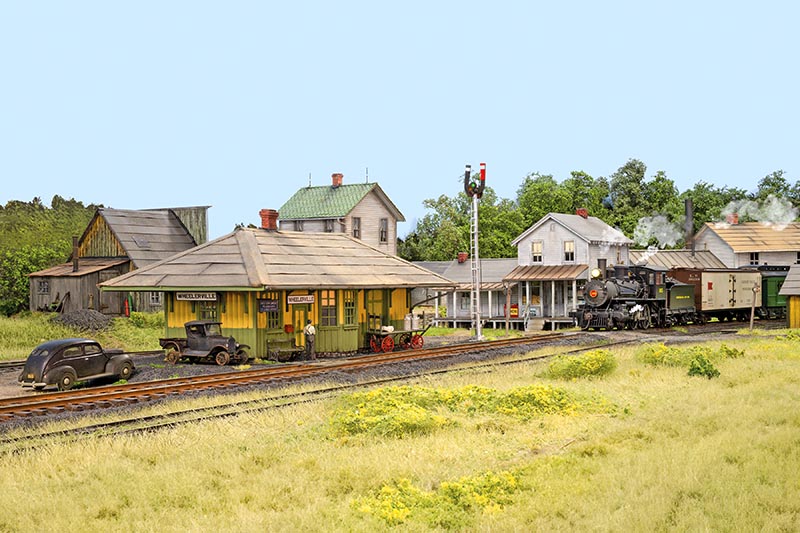
ABOVE: Afternoon westbound passenger Train 3 arrives in Wheelerville. The train will exchange mail sacks and milk cans at the depot, and then will drop off an empty milk car at the Dairymen’s League creamery.
The theme of the “struggling short line” has always had a certain “romantic” cachet that I believe can add a lot of interest to a model railroad. For example, consider the numerous Colorado narrow gauge layouts featured over the years in the model railroad press, with their swaybacked trains and slowed-down operations. I had taken a few trips to the narrow gauge East Broad Top Railroad years ago, and the immersive atmosphere there had an influence on me as well…


